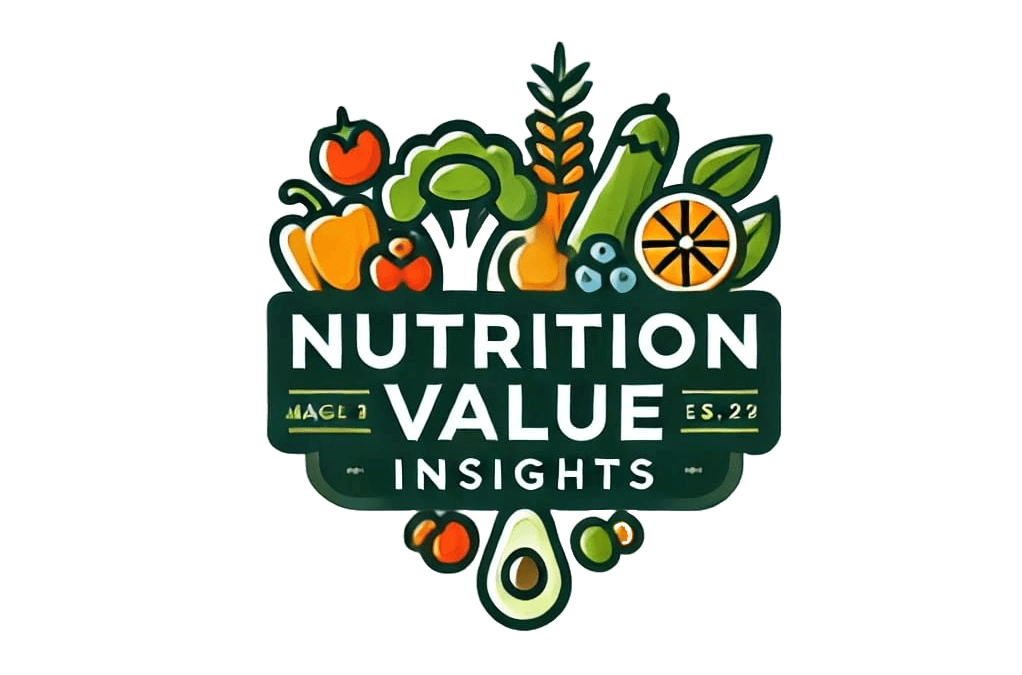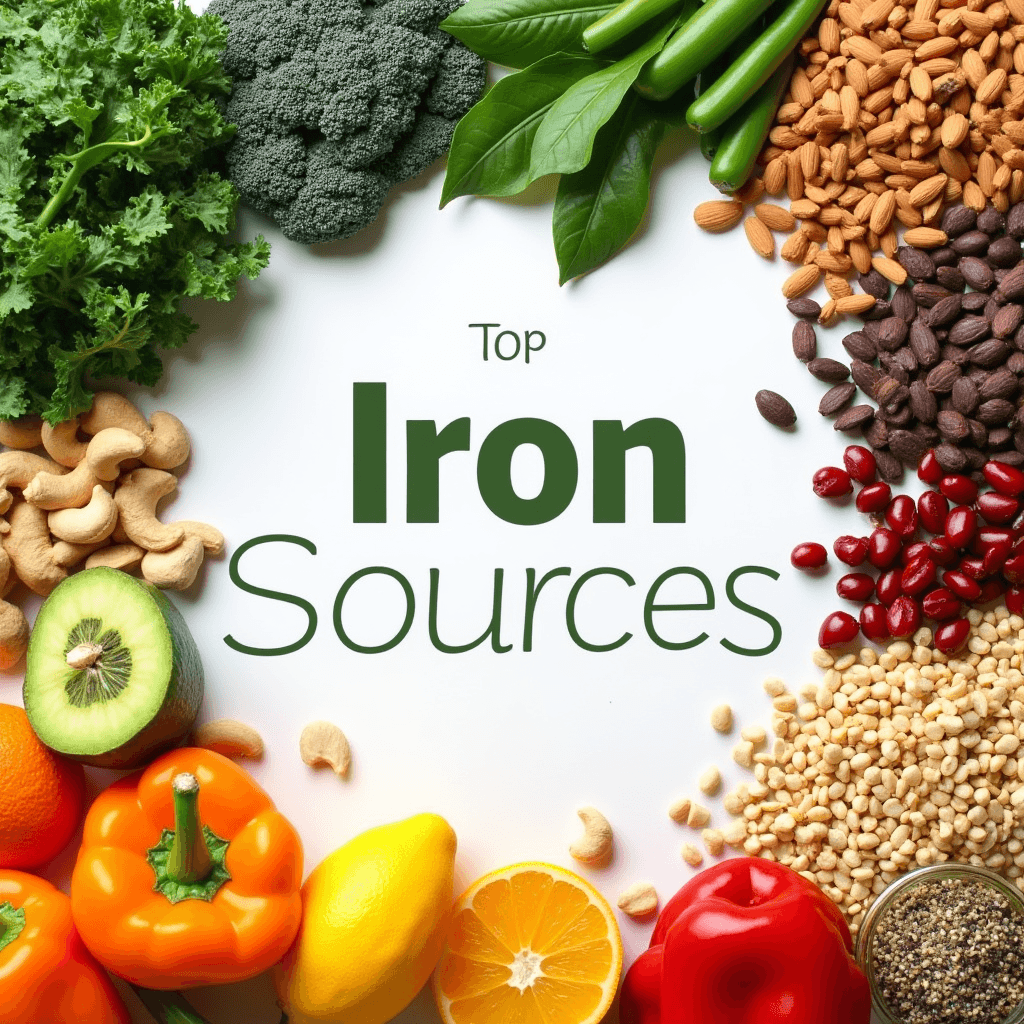Top Iron Sources for Vegetarians: Boost Your Iron Intake Naturally
As a vegetarian, getting enough iron is key for good health and energy. Plant-based diets are full of nutrients, but iron from plants is hard to absorb. Luckily, there are tasty, iron-rich foods that can naturally increase your iron levels. We’ll look at the best plant-based iron sources and how to better absorb this important mineral information nutrition.
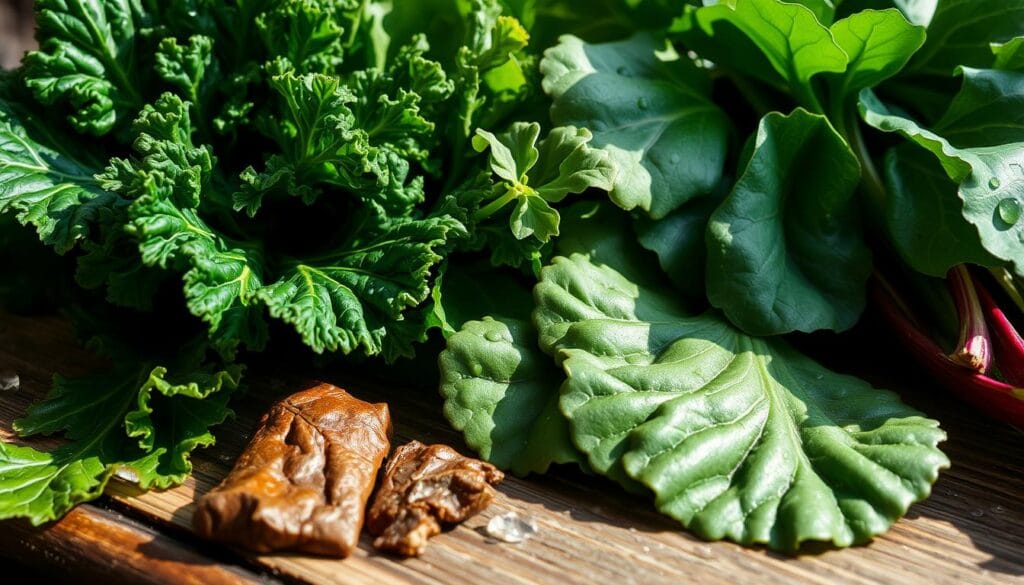
Table of Contents
Understanding Iron Sources for Vegetarians
Vegetarians might face a higher risk of iron deficiency. This is mainly because of how the body absorbs heme and non-heme iron. These are the two main types of iron.
Why Vegetarians are at Risk for Iron Deficiency
The body absorbs heme iron better. It’s found in animal foods like meat, poultry, and fish. On the other hand, non-heme iron, found in plants, is harder for the body to absorb. This makes it tough for vegetarians to get enough iron.
The Difference Between Heme and Non-Heme Iron
Heme iron comes from animal tissues and is easier to absorb. Non-heme iron, in grains, legumes, and veggies, needs more effort for the body to use it. This difference makes vegetarians more likely to have iron deficiency.
To boost iron intake on a vegetarian diet and tackle iron deficiency in vegetarians, it’s crucial to know about non-heme iron sources. It’s also important to find ways to improve their absorption.
Leafy Greens: A Powerhouse of Plant-Based Iron
Leafy greens are the top choice for iron in a vegetarian diet. They are full of non-heme iron, making them a great source. Spinach, kale, Swiss chard, and collard greens are all good options. Adding these iron-rich leafy greens to your meals is tasty and easy.
These greens are not just iron-rich. They also have lots of vitamins and minerals that help your body use iron better. Vitamin C in many leafy greens boosts iron absorption.
To get the most iron from leafy greens, try these tips:
- Make a big salad with spinach, arugula, and romaine lettuce.
- Steam or sauté kale, Swiss chard, or collard greens as a side.
- Blend spinach or bok choy into a smoothie for extra nutrition.
- Add foods high in iron for vegetarians, like leafy greens, to your favorite dishes.
By eating iron-rich leafy greens often, you’ll meet your iron needs. This supports your health and well-being.
Legumes: A Versatile Source of Iron
Legumes are the top choice for plant-based iron. Foods like lentils, beans, and chickpeas are full of non-heme iron. This iron is easy for your body to use. They also have protein, fiber, and B vitamins.
Iron-Rich Lentils and Beans for Vegetarians
Adding iron-rich legumes to your diet is key. One cup of cooked lentils has 6.6 mg of iron. Kidney beans offer 5 mg per cup. Chickpeas give you 4.7 mg of iron per cup.
- Lentils: 6.6 mg of iron per cup
- Kidney Beans: 5 mg of iron per cup
- Chickpeas: 4.7 mg of iron per cup
Legumes are great because they’re easy to use in many dishes. Try them in stews, curries, salads, and dips. You can mix up the flavors and cooking methods to keep things interesting.
Looking to increase your iron intake? Legumes are a great choice. They’re packed with nutrients and will help keep your iron levels up.
Fortified Foods: An Easy Way to Boost Iron Intake
As a vegetarian, getting enough iron can be tough. But, there’s a simple fix – fortified foods. Many foods like breakfast cereals, plant-based milks, and nutritional yeast are now iron-fortified. These foods can really help if you’re finding it hard to get enough iron from whole foods alone.
When you’re shopping, check the nutrition labels for iron content. Fortified foods can greatly increase your iron intake. This makes it easier to meet your daily iron needs without needing supplements. Adding these iron-rich foods to your diet is a smart way to boost iron intake on a vegetarian diet.
Some great fortified food choices for vegetarians include:
- Iron-fortified breakfast cereals
- Plant-based milks, like soy, almond, or oat milk
- Nutritional yeast, which is packed with best vegetarian iron supplements
- Fortified bread and pasta products
By making fortified foods a part of your diet, you can naturally boost your iron intake. This ensures your body gets the nutrients it needs. With a bit of label-reading, you can easily add these foods high in iron for vegetarians to your meals and snacks.
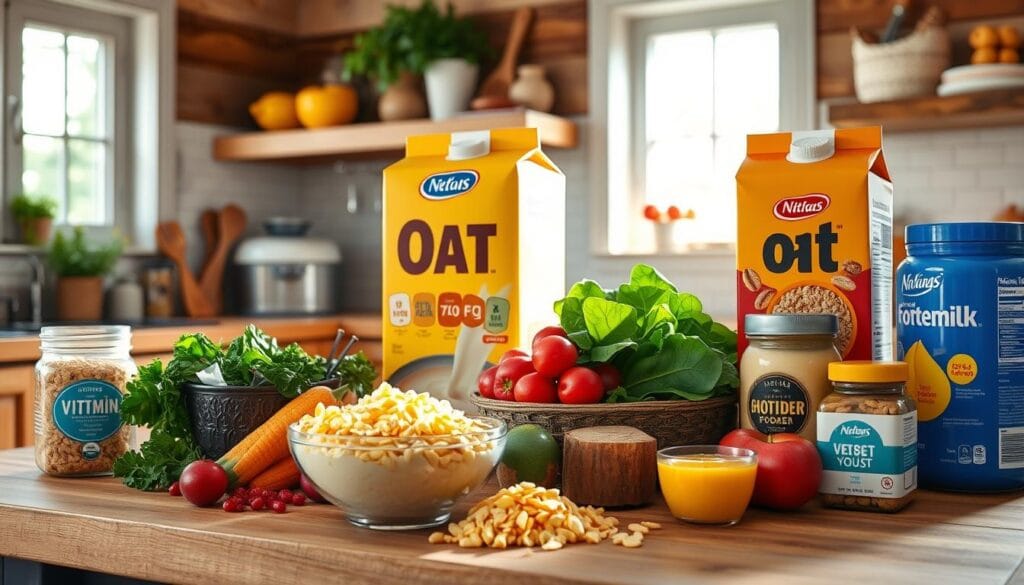
“Fortified foods can be a game-changer for vegetarians who struggle to meet their daily iron needs.”
Nuts and Seeds: A Crunchy Source of Iron
Nuts and seeds are great for vegetarians looking for iron. These snacks are full of nutrients and can help increase your iron levels. Here are some iron-rich nuts and seeds that are easy to add to your meals.
Almonds, Cashews, and Pumpkin Seeds for Iron
Almonds, cashews, and pumpkin seeds are packed with iron. Eating just a small amount can add a lot of iron to your diet. Almonds have about 1.5 milligrams of iron per ounce. Cashews and pumpkin seeds have 1.9 and 4.2 milligrams, respectively.
These nuts and seeds are not just good for iron. They also have protein, healthy fats, fiber, and many vitamins and minerals. Eating a mix of almonds, cashews, and pumpkin seeds can be a tasty way to get more iron and support your health.
| Nut/Seed | Iron Content (per ounce) |
|---|---|
| Almonds | 1.5 mg |
| Cashews | 1.9 mg |
| Pumpkin Seeds | 4.2 mg |
Adding these iron-rich nuts and seeds to your diet is easy. You can snack on them, add them to salads, or use them as a topping. They are a great way to naturally increase your iron intake.
Whole Grains: An Essential Part of an Iron-Rich Diet
Whole grains are a powerhouse for plant-based iron. They are full of non-heme iron and other essential nutrients. Adding quinoa, brown rice, and whole wheat bread to your diet can boost your iron levels.
Whole grains are great for vegetarians because they are rich in plant-based iron sources. Unlike refined grains, they keep the germ and bran, which are full of nutrients. This means they offer a steady flow of non-heme iron, found in iron-rich vegetarian foods.
Whole grains also have fiber, B vitamins, and minerals. This makes them a top choice for foods high in iron for vegetarians. Eating whole grains helps your body get the nutrients it needs to work well.
| Whole Grain | Iron Content (per serving) |
|---|---|
| Quinoa | 2.8 mg |
| Brown Rice | 0.8 mg |
| Whole Wheat Bread | 1.1 mg |
Adding these plant-based iron sources to your diet can help you meet your iron needs. Remember, trying different whole grains can help you find your favorites.
iron source for vegetarians
As a vegetarian, finding enough iron can be tough. But, there are many plant-based options. You can eat leafy greens, legumes, nuts, and seeds. These foods are full of iron and can help your body work well.
Leafy greens like spinach, kale, and Swiss chard are great for iron. They have non-heme iron, which is found in plants. To get more iron from these greens, eat them with vitamin C foods like citrus or bell peppers.
- Spinach
- Kale
- Swiss chard
Legumes like lentils, beans, and peas are also good for iron. They are full of non-heme iron and are easy to add to many dishes. You can make tasty stews or curries with them.
Nuts and seeds, like almonds, cashews, and pumpkin seeds, are also iron-rich. They are not only good for iron but also for other nutrients. They make great snacks.
“Incorporating a variety of iron-rich plant-based foods is key to ensuring you meet your daily iron needs on a vegetarian diet.”
By trying different iron-rich foods, you can make a healthy diet. Find the foods you like and that fit your life. This way, you can stay healthy and feel good.
Dried Fruits: A Sweet Treat with Iron Benefits
Vegetarians looking to increase their iron can find a tasty solution in dried fruits. These foods are full of non-heme iron, making them a great way to add iron to your diet. Apricots, prunes, and raisins are especially good, helping keep your blood and energy levels up.
Apricots, Prunes, and Raisins for Iron
Apricots are a hidden gem for iron. A small serving can give you a lot of your daily iron. Prunes are also packed with iron, offering nearly 10% of your daily needs in one serving. Raisins, being small but mighty, are a tasty way to get plant-based iron.
Adding these dried fruits to your meals and snacks is a simple way to increase your iron intake. Try them in oatmeal, yogurt, or trail mixes for a nutrient boost. You can also bake them into breads and muffins for a sweet, iron-rich treat.
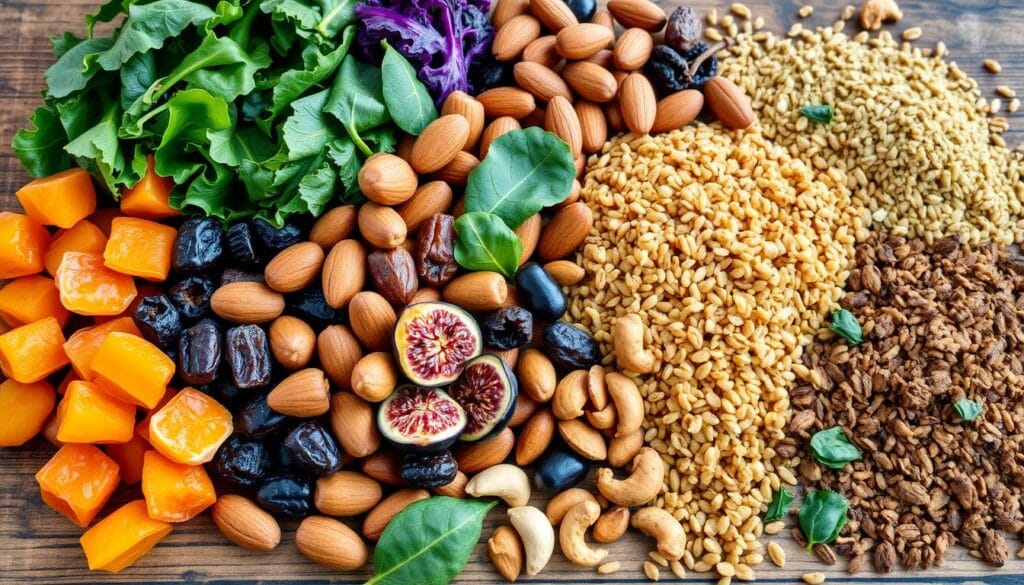
“Dried fruits are a fantastic way for vegetarians to get more iron into their diet. They’re portable, easy to add to meals, and offer a delicious way to meet your iron needs.”
| Dried Fruit | Iron Content (per serving) |
|---|---|
| Apricots | 1.5 mg |
| Prunes | 0.8 mg |
| Raisins | 0.6 mg |
By adding these iron-rich dried fruits to your diet, you can enjoy a sweet way to boost your iron intake.
Iron Supplements for Vegetarians
Even with a well-planned vegetarian diet, some people might not get enough iron. In these cases, iron supplements can be a good choice. Look for supplements made for vegetarians and designed to help your body absorb iron better. Always talk to a healthcare professional before starting any supplement.
Vegetarians and vegans often face iron deficiency because plant-based foods have less heme iron. Heme iron is easier for the body to absorb. Taking non-heme iron supplements can help fill this gap and ensure your body gets enough iron.
Tips for Choosing the Best Vegetarian Iron Supplements
- Look for iron supplements that use iron salts, such as ferrous sulfate or ferrous gluconate, rather than synthetic iron.
- Choose supplements that include vitamin C, as it can enhance the absorption of non-heme iron.
- Consider supplements that contain additional nutrients, like B-vitamins, to support overall health.
- Avoid supplements with fillers, additives, or artificial ingredients that may be derived from animal sources.
Always talk to a healthcare professional before starting any new supplement, especially if you have health issues or take other medications. With the right vegetarian iron supplements, you can boost your iron intake. This helps keep your iron levels high on a plant-based diet.
Increasing Iron Absorption: Tips and Tricks
As a vegetarian, it’s key to boost non-heme iron absorption. This type of iron is found in plant-based foods. There are easy ways to increase iron intake and help your body use it better.
Combining Iron Sources with Vitamin C
Pairing iron-rich foods with vitamin C is a great strategy. Vitamin C, or ascorbic acid, helps your body absorb non-heme iron better. Mix foods like leafy greens, legumes, or fortified cereals with vitamin C-rich foods like citrus fruits, bell peppers, or broccoli.
For instance, a spinach salad with orange segments or a lentil curry with bell peppers can help. These combinations enhance non-heme iron absorption in plant-based foods.
- Pair iron-rich foods with vitamin C-rich foods to increase non-heme iron absorption.
- Combine leafy greens, legumes, or fortified cereals with citrus fruits, bell peppers, or broccoli.
- Vitamin C can enhance the body’s ability to absorb non-heme iron by up to 85%.
By following these tips, you can how to increase iron absorption effectively. This ensures you get enough non-heme iron absorption and boost iron intake on a vegetarian diet. Focus on iron-rich foods and add vitamin C sources to improve your iron levels and health.
“Combining iron-rich foods with vitamin C can increase non-heme iron absorption by up to 85%.”
Meal Planning for Optimal Iron Intake
To meet your daily iron needs on a vegetarian diet, eat a variety of iron-rich foods. Focus on foods high in iron for vegetarians like leafy greens, legumes, whole grains, nuts, seeds, and dried fruits. This way, you can boost iron intake on a vegetarian diet and stay healthy.
For vegetarian sources of iron, mix different iron-rich foods in your meals. For instance, have a leafy green salad with lentils or chickpeas. Or, try oatmeal with almonds and dried apricots. This combination helps your body absorb more non-heme iron from plant-based sources.
When planning meals for iron, think about when and what you eat. Eating vitamin C-rich foods like citrus fruits or bell peppers with iron-rich meals boosts absorption. Also, avoid iron-inhibiting foods like coffee, tea, or calcium supplements around meal times. This helps your body use iron from plant-based foods better.
FAQ
Why are vegetarians at risk for iron deficiency?
Vegetarians are more likely to have iron deficiency. This is because the body absorbs iron from animal products better than from plants. Plant-based foods have a different type of iron.
What is the difference between heme and non-heme iron?
Heme iron is found in animal products like meat and fish. It’s easier for the body to absorb. Non-heme iron is in plants and harder to absorb.
What are the best plant-based sources of iron for vegetarians?
Good sources of iron for vegetarians include leafy greens and legumes. Nuts, seeds, whole grains, and fortified foods are also great. These foods help meet iron needs.
How can vegetarians improve the absorption of non-heme iron?
To better absorb non-heme iron, eat it with vitamin C. Foods like citrus fruits and leafy greens help. Vitamin C boosts iron absorption.
When should vegetarians consider taking iron supplements?
Some vegetarians might need iron supplements, even with a good diet. Look for supplements made for vegetarians. They help the body absorb iron better. Always talk to a doctor before starting supplements.
How can vegetarians incorporate more iron-rich foods into their meals?
To get enough iron, eat a variety of iron-rich foods. Focus on leafy greens, legumes, and whole grains. Nuts, seeds, and dried fruits are also good. This way, you can meet your iron needs and stay healthy.
DID OUR INFORMATION HELP YOU ?
There are no reviews yet. Be the first one to write one.
